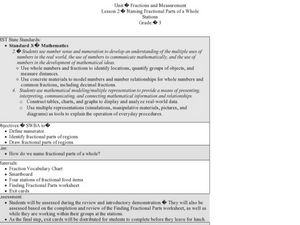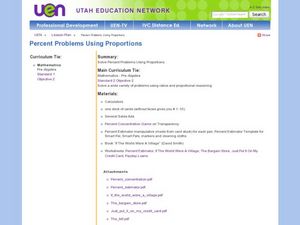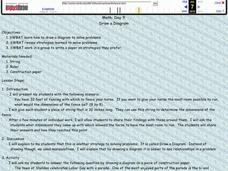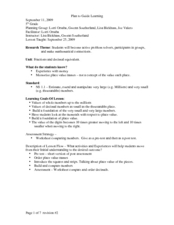Curated OER
What's the Spin?
Learners use the CABRI application for their graphing calculator to rotate, translate, and reflect triangles. They use graphing calculators and follow detailed directions to manipulate triangles in specified ways. There are three...
Curated OER
Mr. Bo Jangle, What's Your Angle?
Third graders explore angles. In this geometry lesson, 3rd graders identify and define acute, obtuse, and right angles. Students form angles with their bodies, find angles in picture books, and record angles found outside in their math...
Curated OER
International Festival: France
Students explore French culture. In this cross-curriculum social studies lesson, students listen to Madeline by Ludwig Bemelmans and identify words and landmarks associated with France. Students pronounce several phrases in French,...
AIMS Education Foundation
Shifty Shapes
Shape shifters examine and experiment with pattern shapes. In this geometry lesson, they work in groups to name and describe pattern block shapes, and they discover the combinations of shapes that can be placed inside a hexagon.
Curated OER
Solids in the Playground
First graders locate and identify solids in the schoolyard. In this geometric solids lesson plan, 1st graders locate two solids on the playground. They work as a group to compare and contrast them according to shape, texture, weight,...
Curated OER
Naming Fractional Parts of a Whole
Third graders complete a worksheet. In this fractions instructional activity, 3rd graders review fraction vocabulary, use the SmartBoard to divide fractions and complete stations where they work with fractional parts of a whole.
Curated OER
Plunge Into Place Value
Students use expanded notation. In this mathematics activity, students determine the place value of a digit within a whole number. Students use manipulatives, words, and symbols to represent whole numbers.
Curated OER
Tessellations WOW!
Students identify and manipulate shapes to create tessellations. In these geometry/spatial relations lessons, the students use of a variety of modalities such as literature, music, writing, and art as introductions to the concept of...
Curated OER
Quadrilateral Attributes
Students classify quadrilaterals. In this quadrilateral lesson, students identify the characteristics of quadrilaterals. They write their findings in a journal. Students use geoboards to create quadrilaterals from given descriptions.
Curated OER
Angles, Triangles, Quadrilaterals, Circles and Related
Middle schoolers classify angles. In this angles lesson, students explore the characteristics of angles, triangles, quadrilaterals and circles. They identify polygons and sing a classifying angles song. Middle schoolers participate in...
Curated OER
Finding Area of Similar Figures
Students explore the concept of finding area of similar figures. In this finding area of similar figures instructional activity, students use pattern blocks to construct similar figures. Students trace their construction and find the...
Curated OER
Solve Percent Problems Using Proportions
Young scholars explore proportions and ratios. In this solving percent problems lesson, students examine percent problems including tax and percent of change.
Curated OER
The Magic Pot
In this reading comprehension lesson, students use the book "The Magic Pot," to explore many concepts including; story elements, sequencing, and phonics. Students also practice making doubles using coins and "magic pots." This very...
Curated OER
Medieval Money
Learners investigate the history of money as it was back then compare to now. In this algebra lesson plan, students analyze the type of money used in medieval times, the value of the currency and the coins used. They make a budget using...
Curated OER
Draw a Diagram
Students draw diagrams to help them solve word problems. In this geometry lesson, students follow step by step directions to set up a word problem and solve it. They write a paper on their prefer rules or strategies.
Curated OER
Fraction Fun
Students define properties of fractions and solve for them. In this algebra lesson, students rewrite fractions from mixed numbers to improper fractions. They reduce fractions using the GCF and convert the denominators correctly when...
Curated OER
Polydron Fun
Students investigate nets as they relate to volume and area. In this geometry lesson, students use nets as a visual to deepen their understanding of surface area and volume of objects. They make conjectures about different objects and...
Curated OER
Transforming Snoopy Using Coordinates
Students graph coordinate points to create a picture of Snoopy. In this coordinate point lesson, students read a book and learn about Rene Descartes' invention, the coordinate grid. Students graph a surprise picture on...
Curated OER
Introducing Powers and Models
Students construct two dimensional models to illustrate squared numbers. In this geometry lesson, students use graph paper and an x/y axis to build squares exponentially. Students identify powers and relationships between various figures...
Curated OER
Hands-On Equations
Use this activity with the Hands-On Equations kit of manipulatives. Learners find the value of x in 5 equations, then check their answers. A great addition to your math lesson!
Curated OER
Basic Right Triangles
Elementary schoolers examine the attributes of triangles. In this triangle lesson plan, learners compare regular triangles and right triangles. They explore vertices and angles and investigate obtuse and acute angles. Pupils draw...
Curated OER
Subtract Positive and Negative Integers
Review the concept of subtracting positive and negative integers. Learners review the rules for subtracting integers, use manipulatives to visualize the process, and complete an assessment.
Curated OER
Fractions and Decimal Equivalents: Fifth Grade
Sometimes a skeleton is all you get. This lesson outline provides teachers with a basic lesson flow. Pupils will pre-test, order place value names, use manipulatives, and build and compare numbers. How this is to be done is not...
Curated OER
Basic Equivalencies
First graders manipulate plastic coins to show equivalencies between pennies and dimes and to show specific values using them. They practice independently to stamp different values a variety of ways.

























